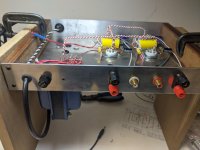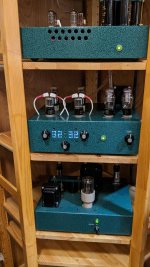Quick question (I believe). I built a preamp with 2C22 and #76 tubes. There are specs as to how far out of level one may run these tubes but what about for testing? Can I set the unit at a convenient angle for a few, maybe up to 15 minutes, for measuring purposes or is that risking damage? This question is really in general not specific to these tubes.
I can certainly hook up my test leads and measure once the amp is level but that is somewhat labor intensive.
I can certainly hook up my test leads and measure once the amp is level but that is somewhat labor intensive.
Do either of these tubes have restrictions on the physical orientation direction?
Are you referring to what happens when the cathode touches the grid?
How long can you run the tube at zero bias is the first question.
Orient the tube wrong, and see what happens.
And, if you are using a grid choke or a interstage winding to the grid, think what happens when the cathode contacts the grid.
Will the cathode pass large currents to the grid wires. Will some of the (very fine) grid wires be welded or opened. Not good.
Your results are partly dependent on all of the grid circuitry, cathode circuitry, tilt angle, and the variance from tube to tube versus tilt to destroy.
Direct Heated Triodes, and some rectifier tubes are a completely different matter. Orientation restrictions may apply.
Your Mileage May Vary.
Are you referring to what happens when the cathode touches the grid?
How long can you run the tube at zero bias is the first question.
Orient the tube wrong, and see what happens.
And, if you are using a grid choke or a interstage winding to the grid, think what happens when the cathode contacts the grid.
Will the cathode pass large currents to the grid wires. Will some of the (very fine) grid wires be welded or opened. Not good.
Your results are partly dependent on all of the grid circuitry, cathode circuitry, tilt angle, and the variance from tube to tube versus tilt to destroy.
Direct Heated Triodes, and some rectifier tubes are a completely different matter. Orientation restrictions may apply.
Your Mileage May Vary.
Last edited:
Tube data sheets list orientation restrictions.
No restriction listed, either there are no restrictions, or the data sheet was incomplete.
DHT tubes and certain rectifiers are the most commonly orientation-restricted tubes.
When testing an amp, I turn the amp upside down, use books at the corners to keep the tubes off the table, and that works.
Careful, do not knock the amp off the books.
No restriction listed, either there are no restrictions, or the data sheet was incomplete.
DHT tubes and certain rectifiers are the most commonly orientation-restricted tubes.
When testing an amp, I turn the amp upside down, use books at the corners to keep the tubes off the table, and that works.
Careful, do not knock the amp off the books.
WntrMute2, and kuroguy,
K.
Most preamp tubes that are IDHT do not have orientation restrictions.
A lot of high power IDHT transmitting tubes do have orientation restrictions.
Generally, DHT have orientation restrictions.
Directly Heated Rectifiers, a couple of examples:
The type 80 rectifier, vertical is preferred, but if mounted horizontally, pins 1 and 4 must be either at the top or at the bottom.
Its sibling, the 5Y3 vertical is preferred, but if mounted horizontally, pins 2 and 8 must be in a horizontal plane.
There are many tubes that can be mounted both vertically and horizontally, but they may have a particular rotation orientation required when they are mounted horizontally.
If vertical and horizontal are mentioned in the data sheet, chances are that mounting at an angle other than that is not a good idea.
Most modern data sheets do not list the orientation restrictions.
Do a search for Franks tube data pages. He has lots of old data sheets, mixed in with the new data sheets.
You never said what tubes you are using in your preamp(s).
W.
Thanks for the great idea!
I have some clamps, and I have some boards that will work.
Happy building, and happy listening to both of you.
K.
Most preamp tubes that are IDHT do not have orientation restrictions.
A lot of high power IDHT transmitting tubes do have orientation restrictions.
Generally, DHT have orientation restrictions.
Directly Heated Rectifiers, a couple of examples:
The type 80 rectifier, vertical is preferred, but if mounted horizontally, pins 1 and 4 must be either at the top or at the bottom.
Its sibling, the 5Y3 vertical is preferred, but if mounted horizontally, pins 2 and 8 must be in a horizontal plane.
There are many tubes that can be mounted both vertically and horizontally, but they may have a particular rotation orientation required when they are mounted horizontally.
If vertical and horizontal are mentioned in the data sheet, chances are that mounting at an angle other than that is not a good idea.
Most modern data sheets do not list the orientation restrictions.
Do a search for Franks tube data pages. He has lots of old data sheets, mixed in with the new data sheets.
You never said what tubes you are using in your preamp(s).
W.
Thanks for the great idea!
I have some clamps, and I have some boards that will work.
Happy building, and happy listening to both of you.
Last edited:
Quick question (I believe). I built a preamp with 2C22 and #76 tubes. There are specs as to how far out of level one may run these tubes but what about for testing? Can I set the unit at a convenient angle for a few, maybe up to 15 minutes, for measuring purposes or is that risking damage? This question is really in general not specific to these tubes.
I can certainly hook up my test leads and measure once the amp is level but that is somewhat labor intensive.
Yes I did post the tube types in the original text and I had checked Frank's data sheets prior to posting. The 2C22s have specs and I am adhering to them in their running orientation. I was just asking about during a few minutes of testing tube voltages as the location of the tubes, tube cap wires and transformer made balancing it on books precarious. Since you were so adamant about disaster I had the unit off, positioned the leads and then turned the preamp right side up prior to each voltage test. Took about 8 cycles but all sees fine. Unit in question is the unit in the middle of the stack.
I decided to splurge and by a premade amp stand for future stability.
Thanks for the help all.
Mojotone Amplifier Chassis Stand
Attachments
WntrMute,
I forgot that you listed the tube types (it happens at this age).
I think the only way to find answers to how long we can violate the orientation, is only answered by running them that way until they fail.
I would expect the length of time to depend on the filament voltage, and the plate dissipation (and if there is a screen, its dissipation) your circuit runs the tube at.
I would also expect it to vary from tube to tube, especially if there are any differences in construction of one manufacturer to another manufacturer.
I believe the main factor is simply a function of heat, and one or more elements moving out of place, and sagging.
Generally, the only elements of the tube that can radiate their heat outside of the tube is the plate.
The filament, cathode, control grid, screen grid suppressor grid/beam formers, can only radiate their heat to the plate, they are captive elements.
During an orientation violation:
The first step is a change in tube characteristics.
The second step is a short.
Neither of those is a good thing.
I forgot that you listed the tube types (it happens at this age).
I think the only way to find answers to how long we can violate the orientation, is only answered by running them that way until they fail.
I would expect the length of time to depend on the filament voltage, and the plate dissipation (and if there is a screen, its dissipation) your circuit runs the tube at.
I would also expect it to vary from tube to tube, especially if there are any differences in construction of one manufacturer to another manufacturer.
I believe the main factor is simply a function of heat, and one or more elements moving out of place, and sagging.
Generally, the only elements of the tube that can radiate their heat outside of the tube is the plate.
The filament, cathode, control grid, screen grid suppressor grid/beam formers, can only radiate their heat to the plate, they are captive elements.
During an orientation violation:
The first step is a change in tube characteristics.
The second step is a short.
Neither of those is a good thing.
Last edited:
I think he thought you talked about a new design using DHT triodes mounted in a not conventional position, testing those tubes in a tilted position cannot harm them unless you leave them running like that for months or even years, the reason you wont hear about that in datasheets is cause they arent so prone to failing of mechanical/mounting defects, like some other tubes that truly had that issues.
- Status
- This old topic is closed. If you want to reopen this topic, contact a moderator using the "Report Post" button.
- Home
- Amplifiers
- Tubes / Valves
- How Long?

